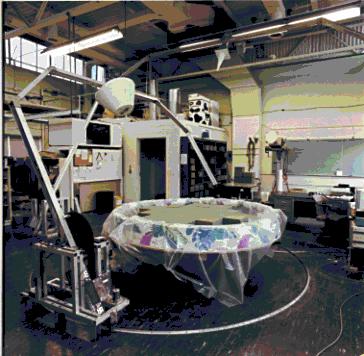
Here's a photo of the University of Michigan Bistatic Measurement Facility, the radar lab that has a part of my personality built into it. I use it to measure the bistatic radar scattering from rough surfaces, which is my dissertation topic. Most radars operate in backscatter mode, where the transmitter, the source of radar illumination, and the receiver are the same antenna, or two antennas located really close to each other (relative to what they're looking at). It's like walking around at nite and all you can ever see is what you point your flashlite at. You don't see shadows, for one thing.
Bistatic radar is where the transmitter (the source of light) and the receiver (your eyes) are located independently of each other. It's like everyday life for us: our eyes, the sun, and what we're looking at are not constrained to particular geometries. There's very little bistatic radar research out there. I'm doing some.
The radar operates at 9.25GHz, which corresponds to an electromagnetic wavelength of about 3cm. This is close to the frequencies used by some police radars and not far off from those used in microwave ovens (2.45GHz). By contrast, our eyes detect electromagnetic waves of about 400nm to 900nm, which is about one fifty-thousandth as long. On the left is a dual polarized transmitter mounted on an arch which can go from 0 to 90 degrees in elevation and 0 to 360 in azimuth. Above and to the right is a dual polarized transmitter/receiver, which ranges from 0 to 90 in elevation. The target holder consists of a kiddie pool mounted on a turntable; the target is a set of green "Oasis" bricks in this photo. A possible alternative material is rockwool, a hydroponic growing medium. Photo credits belong to Ralf Zaar, stepfather of Mike McCurdy.
geddylee@engin.umich.edu Thanks Mike! Last updated Apr 25, 1996